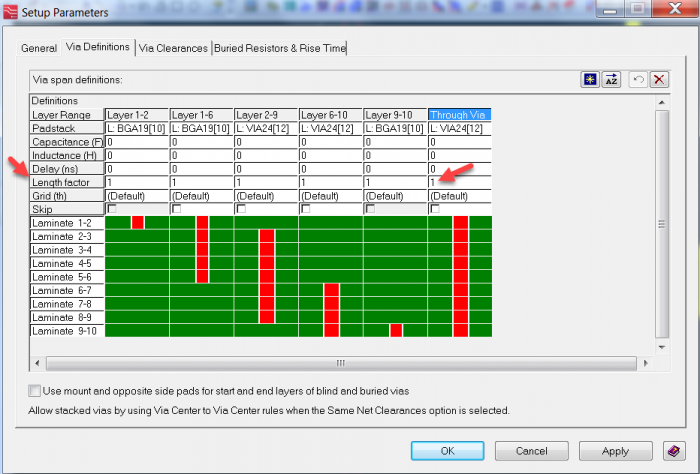Effect of delay and pin lengths of the microcircuit and software on the calculation of the total length / delay of conductors

Constraint manager in PADS Professional / Xpedition provides users with full control over all parameters that affect the integrity of high-speed signals. Today we will analyze how the influence of pin length and delays of the microcircuit pin, as well as the effect of vias, can be included in the calculation of the total length of the conductor.
All the most interesting under the cut.

In this article I will try to answer the following questions:
- Software length factor
- Is it possible to simultaneously enter length and delay limits for outputs in Constraint Manager?
- What is the effect of delays and lengths on pins on the “Part” tab in CES?
- How does the “Tuning meter” tool work when using the pin length and software length parameters?
- The effect of software delay on calculating the total signal delay
Setting the output delay in Constraint Manager
In PADS Professional / Xpedition version VX2.2 and above, you can simultaneously import a file with delays and pin lengths directly into the constraint input system.
To import, open CES, go to File> Import> Package Delays and select your file with delays:

The PinPkgDelays / PinPkgLengths file format (* .txt /.* ppd / *. Ppl) is as follows:

Where unit is the format (does not depend on the register):
- for the delay, seconds (s), milliseconds (ms), microseconds (us), nanoseconds (ns) and picoseconds (ps)
- for length - thousandths of an inch (th), microns (um), millimeters (mm), inches (in)
part_name is a keyword that uniquely identifies your
pin_number chip , value — here you can see the output number and the corresponding length / delay value
Important : the import tool does not support the comma format, even if you define them as CES separators.
A small example of the PinPkgDelays.txt file:

Automatic calculation of delay values
If you have information only about the length of the chip pins, you can use the CES to automatically calculate the delay of conclusions based on the propagation delay determined at CES settings (the Setup> the Settings) :

Once you have specified lead length values, click right-click in the cell of the corresponding contact delay and select Calculate Delay and the system will automatically calculate the value:

Below are examples for different use cases for Via Lengths, Via Delay and Pin Package Lengths.
Example №1
In this example , the Via or Pin Package Length parameters are not used:

Adding 100th length to each component pin U1 gives the following values: The

Tuning Meter now displays the conductor length values, taking into account the added 100th to each component pin:

Example 2
Now go to the Setup> Setup Parameters menu and on the Via Defenitions tab, set the Via Length Factor value to 1 .

Note: the software length value is calculated based on your board stack. Also note that for calculating the software length, the copper thickness of the initial and final layers is NOT taken into account. The figure below shows how the software signal length is calculated, moving from layer 1 to layer 3 and from layer 3 to layer 8: The

actual length of the conductor in the constraint manager changes as soon as we set the software length ratio:

Now the length of the conductor displayed in the Tuning Meter , includes the ratio of the length of the software and the length of the conclusions:

Example number 3
At this stage, we will add a Pin Package Delay delay of 0.02 ns:
Let's see for clarity the delay values calculated for the conductor in TOF mode , provided that the Pin Package Delay is set to 0 :

Now we set the value for Pin Package Delay to 0.02 ns : The

delay in the restrictions manager for this signal has changed to 0.02, and we can be convinced of this:

Example 4
Now let's consider the case when Pin Package Delay and Pin Package Length are installed simultaneously, as well as Via Delay and Via Length Factor and how this will affect the calculation of the total length / delay of the conductor.
The figure below shows the propagation delay in the conductor at zero Pin Package Delay and Via Delay in the Tuning Meter:

The next step is to set the Pin Package Delay to 0.02 ns and see the changes:

Now, if we specify another value in the Pin Package Length or Via field Lenght Factor, the value of the delay does not change, since we are working in TOF mode .
But if we set Pin Package Delay and Via Delay to 0.02 ns, we get the following result:

In the constraint editor, the signal propagation delay through the conductor with the Pin Package Delay and Via Delay parameters set with 0.02 ns will look like this:

Via Delay and Via Length Factor can be configured via the Setup> Setup Parameters menu in the Via Defenitions tab:

Conclusion
The PADS Professional / Xpedition restriction entry system allows you to set both the length of the pins and the delay values, but if you have set the signal propagation time ( TOF ) in CES , the system will use the values from the Pin Package Delay cell , and if length ( the length ) - the system will take the value from the cell Pin the Package lengths .
The same goes for software impact. If the delay type defined in the constraint manager is set to Length , then the length factor ( Via Length Factor ) software will be used ; in the case of TOF , the value of Via Delay will be used.
I hope that it turned out not too cumbersome and confusing.
All incomprehensible moments are ready to be discussed in the comments.
Filipov Bogdan PBO , Product-manager on PADS solutions
